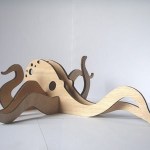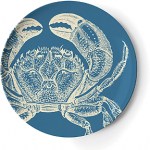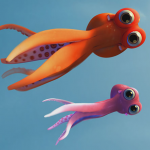Cephalopodmania
The Princeton Art of Science competition has named its 2009 winners. The image above, by Celeste Nelson, is a bright field micrograph of baby squid (Loligo pealeii). See the rest of the winners here.
One of the sucky things about viral interest in offbeat art from small vendors is that it always immediately depletes the supply. Like this fabulous minimalist plywood octopus from inthewoods' etsy shop. Sure, you can still get a plywood squirrel with a plywood acorn, but where's the sinister, feverish Cthulhulian majesty in that? Frustrated now!
Via monoscope
Lately, I've been seeing a lot of dinnerware that's just too fascinating to cover with food. Like Hiroshi Tsunoda's Bodylicious plates, available at DesignCode. According to Street Anatomy, Tsunoda was
inspired by Nyotaimori, a tradition where food is presented on a naked woman's body and used as a tray. Nyotaimori is also referred to as body sushi, and requires the person to practice laying for hours without moving.
Wow, I'm not sure what to say. But at least the plates are equal opportunity: there's a Bodylicious Y set too!
Moving from Homo sapiens to marine invertebrates, these…
It wasn't that long ago that Otto the octopus was bent on destroying the electrical system in his German aquarium. Now a cephalopod at the Santa Monica aquarium is following in his footsteps, flooding the building overnight with a few hundred gallons of seawater:
The suspected cephalopod weighs about a pound. Its head is about the size of a football and its tentacles are twice as long, aquarium spokeswoman Randi Parent said. "She's done this before, but this is the first time she's done it while no one was around."
Oh. . . so she's done this before. Nice.
Update: an interview with an octopus…
My favorite Academy Award nomination: Oktopodi. By Emud Mokhberi and Thierry Marchand. Read an interview with Mokhberi - chock full of storyboard images, video, and other goodies - here.
These charming photos by bre pettis capture a lovely, detailed diorama at the Natural History Museum in Vienna. I'm not sure how old it is, but it's very cool.
Something Rich and Strange
Jessica Palmer, 2008
Merry Christmas and Happy Hanukkah from Bioephemera!
A big thank you to everyone who reads and comments on my blog - you are why I do this. Enjoy your holiday and have a wonderful New Year!
Jess
. . . at least according to XKCD:
(All right, fine: they're acknowledging cephalopods' supremacy, not biologists'. It's probably a ploy to lull us into complacency while they corrupt our cuttlefish minions and eventually wipe us out.)
This Indonesian mimic octopus pretends to be other creatures in order to avoid predators:
UK Reef (detail) - with candy striped anemone by Ildiko Szabo (foreground) and anemone grove by Beverly Griffiths (background). Photo by George Walker.source
This afternoon at the Smithsonian Museum of Natural History, physicist Margaret Wertheim of the Institute for Figuring will be giving a lecture and workshop on crocheting coral reefs with the "hyperbolic crochet" technique. While her creations can't replace the real reefs that are rapidly disappearing, they are purdy, and some of the forms are remarkably similar to real species of coral, diatoms, and anemones.
More about the crochet…
Wall of Fishes, Vanderbilt Museum
from Curious Expeditions
Nothing symbolizes the amateur naturalist's aesthetic as well as a wall of preserved specimens in glass jars, like the jewellike Wall of Fishes in the Vanderbilt Museum (captured here by the wonderful Curious Expeditions, in a fascinating slideshow treasure gallery of the Vanderbilt).
A similar glistening room of glass is found in my revious post about London's Hunterian Museum.
The problem with historical specimen collections like these is that slowly but surely, they're falling apart. Storing biological tissue in alcohol or…
From NPR: The staff at a German aquarium trained 6-month old Otto the octopus to aim and squirt water at targets. It was all fun and games for awhile, but then the devious cephalopod turned his powers against his captors, squirting the lights in his enclosure and repeatedly shorting out the aquarium's electrical system. Bwahahaha, take that, foolish humans!
Haven't these people read Lovecraft?
Complete podcast here.
Amazingly, it's already the last week of the DonorsChoose fundraising drive! SEED has generously kicked in matching funds for each blogger, which enabled me to contribute to several more projects - but we only have a total of $1,026 so far. That's much less than Chad is getting for promising to dance like a monkey.
Honestly, I'd dance like a monkey too, but none of you wants to see that, I promise you. I have no rhythm whatsoever.
So here it is, readers: I'm going to do something to persuade you to donate, too. I'm going to give away a painting. A new, original, watercolor painting that I am…
Tentacles with Synthetic Flowers
Liz Wolfe, 2004
Liz Wolfe mixes sugar, spice, and everything nice with snakes, snails, and lots of raw meat. Her gallery is like a garden party from twisted suburbia, where cupcakes are topped with screws, cakes bleed, and floors are paved with ham. You may never eat candy again.
Thanks to Rhett for this one!
Squid Suckers
Jessica Schiffman and Caroline Schauer (Drexel University)
Honorable Mention, Science and Engineering Visualization Challenge 2008
The September 26 issue of Science contains the annual S&E Visualization Challenge winners. The feature is pay-only, but the winners are summarized in a free slideshow here. Winners and honorable mentions include short films, web interfaces, photos, micrographs, and digital illustrations (unfortunately, as in previous years, traditional media is somewhat underrepresented). The type of content varied too: the picture above is an artificially…
Just in case you aren't following the savage recipe war between Isis the Scientist and PhysioProf, I have to call your attention to PP's latest entry: it's a tentacle salad. You CAN have your cute little squid, and eat it too!
Despite the attractiveness of Isis' steak salad, when it comes to cephalopods I'm a one-issue voter. (Luckily neither of the presidential candidates has taken a position on cephalopods, or I might be placed in an awkward situation.)
For the cephalophile's gift registry: a large octobowl by Hudson Beach Glass. Available here and elsewhere.
Silent Dredge, 2008
Tiffany Bozic
Currently showing at the San Francisco Arts Commission Gallery: "A Complicated Dominion: Nature and New Political Narratives," featuring the work of Tiffany Bozic, among others:
Our dominion is complicated and comes with profound responsibility. Humankind has become adept at leveraging natural resources and scientific advances to not only ensure our survival, but also to support and spread various political agendas. Along the road we have developed life-enhancing technologies and become more widely informed about the necessity of our participation in…
This octopus has 96 arms. That's just not right!
See PinkTentacle for more on this bizarre critter, and another 85-armed specimen. Euw! via Ectoplasmosis and lots of places.
I saw this adorable stuffed cephalopod, which I think is meant to be an octopus, at the gift shop in the Contemporary Arts Center in Cincinnati. I almost bought it out of sheer enthusiasm, but note that like many stuffed octopi, this cutie has only six legs. I've noticed that stuffed cephalopods frequently have six or even seven legs - what part of "octo-pus" is so hard to understand? Harumph.



